Most Common Houseplant Pest Infestations:
Click a pest image to see details & care

Aphids
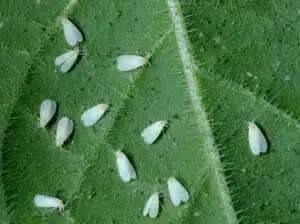
Common Whitefly
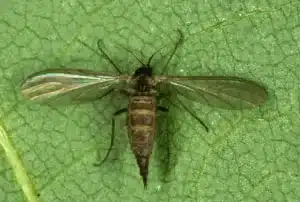
Fungus Gnats
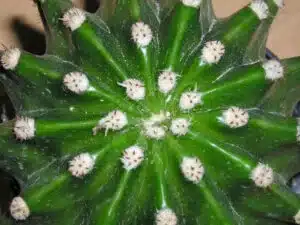
Mealybugs
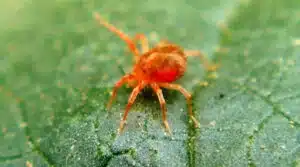
Red spider mites
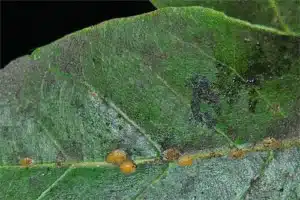
Scale
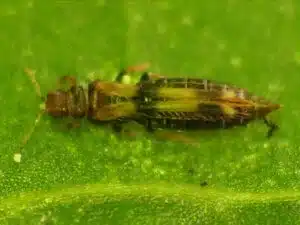
Thrips
Pest Details
Scale (Coccus hesperidum)
Scale insects, specifically Coccus hesperidum, are common garden pests that can harm your plants. They appear as small, oval-shaped, and often immobile bumps on plant stems and leaves. These bumps can vary in color from brown to gray to white, depending on the species. The most visible sign of scale infestation is the sticky honeydew they excrete, which can lead to the growth of sooty mold on plant surfaces. Severely affected plants may display yellowing leaves, stunted growth, and a generally unhealthy appearance.
Scale insects are attracted to plants for their sap, which they feed on by piercing the plant’s tissues with their needle-like mouthparts. They commonly infest a wide range of plants in North America, including fruit trees, ornamental shrubs, and houseplants. To proactively avoid attracting scales, practice good garden hygiene by removing fallen leaves and debris, which can harbor their eggs. Regularly inspect your plants for any signs of scale infestations, particularly on the undersides of leaves and along stems.
To eliminate scale insects organically, use a soft brush or a cotton swab dipped in rubbing alcohol to remove them from plant surfaces. Introducing natural predators like ladybugs or parasitic wasps can help control their population. Neem oil or insecticidal soap can be effective in treating scale infestations, but ensure thorough coverage and follow the product instructions. For more aggressive non-organic methods, consider using systemic insecticides, but use them as a last resort, being mindful of their potential impact on beneficial insects. Regular monitoring and timely action are essential in managing scale insects in your garden.
Pest Details
Mealybugs (Pseudococcidae family)
Mealybugs are common garden pests that can harm your plants. These soft-bodied insects are small, ranging from 1/8 to 1/4 inch in size, and are covered in a white, waxy, cotton-like substance. They have segmented bodies with long, thread-like antennae and often cluster in colonies. Mealybug infestations can lead to yellowing leaves, stunted growth, and a sticky, honeydew residue on plant surfaces. The white, cottony appearance is a distinguishing feature of mealybugs, making them relatively easy to identify.
Mealybugs are attracted to plants due to their sap-sucking habit, which provides them with a source of nutrients. They commonly infest a wide range of plants in North America, including ornamental plants, houseplants, and fruit trees. To proactively avoid attracting mealybugs, regularly inspect your plants for signs of infestation and maintain good plant hygiene. Keep your garden clean from fallen leaves and debris, as these can serve as hiding spots for mealybugs. Isolating new plants for a few weeks before introducing them to your garden can also help prevent infestations.
To eliminate mealybugs organically, use a soft brush or a cotton swab dipped in rubbing alcohol to remove them from plant surfaces. You can also introduce natural predators like ladybugs or lacewings to control the population. Neem oil or insecticidal soap can be effective in treating mealybug infestations, but ensure thorough coverage and follow the product instructions. For more aggressive non-organic methods, consider using systemic insecticides, but use them as a last resort, being mindful of their potential impact on beneficial insects. Regular monitoring and prompt action are essential in managing mealybugs in your garden.
Pest Details
Aphids (Family Aphididae)
Aphids, part of the Aphididae family, are tiny, soft-bodied insects commonly found in gardens across North America. They are usually green or yellow, ranging from 1/16 to 1/8 inches long, with pear-shaped bodies. Aphids can be identified by their two long antennae and the presence of two tube-like structures, called cornicles, on their rear end. Visually, these pests cluster on plant stems and leaves, often appearing as small, slow-moving dots. One visible sign of their presence is the honeydew they excrete, a sticky substance that attracts ants and can lead to sooty mold growth on affected plants.
Aphids are attracted to plants due to their sugary sap. They commonly infest a variety of plants in North America, including roses, vegetables like lettuce and tomatoes, fruit trees, and ornamental shrubs. To proactively deter aphids, consider planting companion plants like marigolds or nasturtiums, which they tend to avoid. Regularly inspect your plants for signs of infestation and hose off aphids with a strong stream of water to dislodge them.
To eliminate aphids organically, you can introduce natural predators like ladybugs or lacewings to your garden. Neem oil or insecticidal soap can also be applied to affected plants, suffocating the aphids. For a more aggressive approach, consider chemical insecticides like pyrethroids, but use them as a last resort, following manufacturer instructions carefully and avoiding harm to beneficial insects. Pruning heavily infested plant parts can also help control the population. Regular vigilance and a combination of these methods can help manage aphids in your garden.
Pest Details
Common Whitefly (Trialeurodes vaporariorum)
The Common Whitefly is a small, winged insect that poses a threat to plants. These tiny insects are typically about 1/16 inch long and have white, moth-like bodies. They are best identified by their distinctive white, powdery wings, which are held in a tent-like fashion over their bodies when at rest. Infested plants often display symptoms such as yellowing leaves, stunted growth, and a sticky residue called honeydew on the leaves. The honeydew can attract ants and sooty mold, which further harm the plant’s health and appearance.
Whiteflies are drawn to plants due to their sap-sucking nature. They are commonly attracted to a wide range of plants in North America, including vegetables like tomatoes and cucumbers, ornamental flowers, and greenhouse-grown crops. To prevent whitefly infestations, maintain good garden hygiene by removing weeds and keeping your garden clean. Use reflective mulch or aluminum foil around plants to deter them, as they dislike the bright, reflective surface. Additionally, introducing natural predators like parasitic wasps or ladybugs can help keep their population in check.
To control whiteflies organically, regularly spray affected plants with a strong stream of water to dislodge them. You can also use insecticidal soap or neem oil, ensuring thorough coverage of the affected areas. For more aggressive non-organic methods, chemical insecticides containing pyrethroids or systemic pesticides can be effective, but use them cautiously, following label instructions and considering their impact on beneficial insects. Frequent monitoring and early intervention are key to managing whiteflies and protecting your garden.
Pest Details
Fungus Gnats (Bradysia sp.)
Fungus Gnats, belonging to the Bradysia genus, are a common garden pest that can affect your plants. These small, delicate insects are usually around 1/8 inch long and have slender, dark-colored bodies with long legs and clear wings. Fungus gnat larvae, found in the soil, are small, white, and worm-like. Infestations often lead to symptoms such as wilting, yellowing, or stunted growth in plants. Adult gnats are frequently seen hovering around the soil surface or near your plants.
Fungus gnats are attracted to damp, organic matter in the soil, making them commonly found in potted plants and garden beds. They are particularly drawn to overwatered or consistently wet soil conditions. To prevent attracting these pests, allow the top layer of soil to dry out between waterings, and avoid over-fertilizing your plants, as excess nutrients can promote fungus growth.
To eliminate fungus gnats organically, allow the soil to dry out a bit, use yellow sticky traps to capture the adult gnats, and introduce beneficial nematodes to the soil to prey on the gnat larvae. You can also apply a layer of sand or diatomaceous earth on the soil surface to deter adult gnats from laying eggs. For more aggressive non-organic methods, consider using chemical soil drenches containing neonicotinoids, but use them sparingly and in accordance with the product instructions. Regularly inspect your plants and maintain proper watering practices to keep fungus gnats at bay.
Pest Details
Red spider mites (Tetranychus sp.) (Panoychus ulmi)
Red spider mites, often referred to as Tetranychus sp. or Panoychus ulmi, are common garden pests that can harm your plants. These tiny arachnids are about 1/50 inch long and typically have a red or yellowish coloration. They have eight legs and are best identified by their fine webbing on the underside of leaves. The presence of tiny, stippled, or speckled discolorations on plant leaves is a visible sign of red spider mite infestation. Severe infestations can cause leaves to become bronzed, wilted, and eventually drop, leading to reduced plant vitality.
Red spider mites are attracted to plants due to their sap-sucking behavior, which provides them with a source of food. They commonly target a variety of plants in North America, including houseplants, ornamental shrubs, fruit trees, and vegetables. To proactively prevent red spider mite infestations, keep your garden well-ventilated and avoid over-fertilizing with nitrogen-rich fertilizers, as these can attract these pests. Regularly inspect the undersides of plant leaves for any signs of mites or their webbing.
To eliminate red spider mites organically, increase humidity around your plants by misting them or using a humidifier, as mites thrive in dry conditions. You can also introduce natural predators like predatory mites or ladybugs to help control their population. Insecticidal soap or neem oil can be used to treat infested plants, but ensure thorough coverage, including the undersides of leaves. For more aggressive non-organic methods, consider using chemical miticides, but use them as a last resort, following the product instructions carefully and avoiding harm to beneficial insects. Regular monitoring and early intervention are key to managing red spider mites in your garden.
Pest Details
Thrips (Order: Thysanoptera)
Thrips are common garden pests that can affect your plants. These tiny insects are about 1/16 inch long and have slender, elongated bodies with fringed wings. Thrips are often brown, black, or yellow in color and have rasping mouthparts they use to pierce plant tissues and feed on the sap. Infestations can cause leaves to develop silvery streaks or become discolored, distorted, or speckled. Additionally, thrips can transmit plant diseases, making them a significant concern for gardeners.
Thrips are attracted to plants for their sap and are commonly found on a variety of plants in North America, including flowers, vegetables, and fruit trees. To proactively prevent thrips, maintain good garden hygiene by removing weeds and debris that can harbor them. Choose plants that are less attractive to thrips, such as those with smooth, glossy leaves. Consider using floating row covers to protect susceptible plants from infestation.
To eliminate thrips organically, use a strong stream of water to dislodge them from plant surfaces. Introducing natural predators like predatory mites or lacewings can help control their population. Neem oil or insecticidal soap can be applied to affected plants, but ensure thorough coverage and follow the product instructions. For more aggressive non-organic methods, consider using chemical insecticides, but use them cautiously, following label instructions and considering their impact on beneficial insects. Regular monitoring and early intervention are key to managing thrips in your garden.
Most Common Outdoor Pest Infestations:
Click a pest image to see details & care
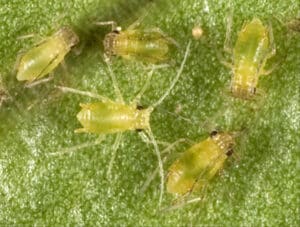
Aphids
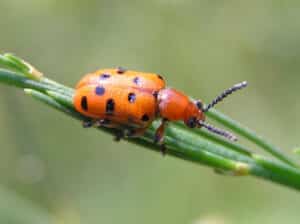
Asparagus Beetle
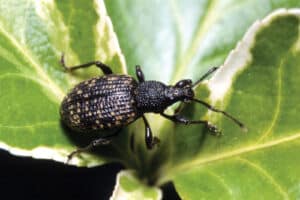
Adult Vine Weevil
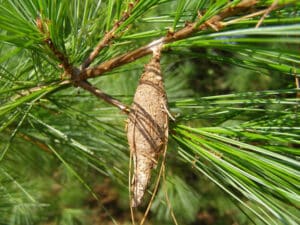
Bagworm

Beetle Grub
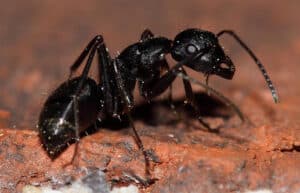
Black Carpenter Ant

Cabbage Looper Caterpillar
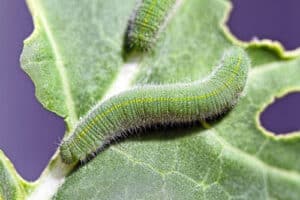
Cabbage White Caterpillars

Codling Moth
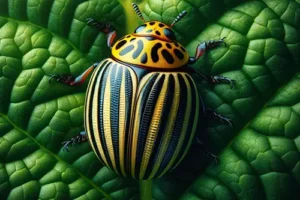
Colorado Potato Beetle
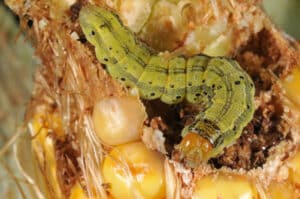
Corn Earworm

Cucumber Beetle
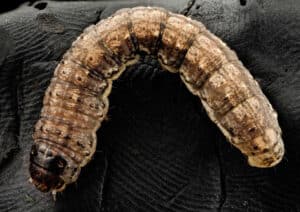
Cutworm
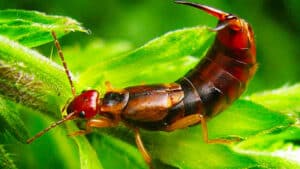
Earwig
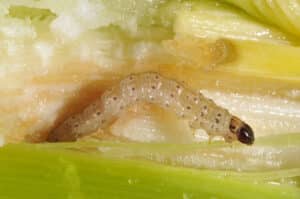
European Corn Borer
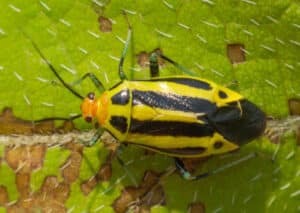
Four-Lined Plant Bug
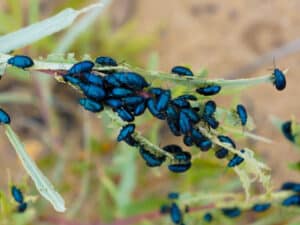
Flea Beetle

Gall Mites

Grasshopper
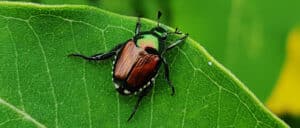
Japanese Beetles

Leaf Miner
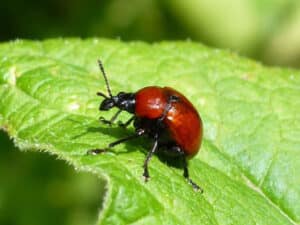
Leaf Roller
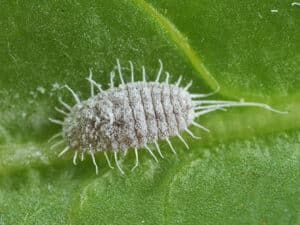
Mealybugs
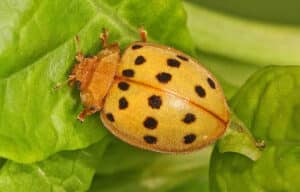
Mexican Bean Beetle
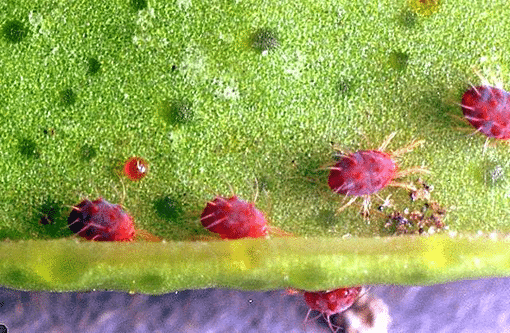
Red Spider Mites

RIFA-Red Imported Fire Ant
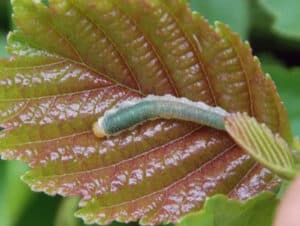
Rose Slug

Sawfly Larvae

Scale Insects

Slugs

Snails
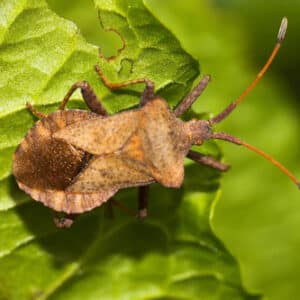
Squash Bug

Stink Bug
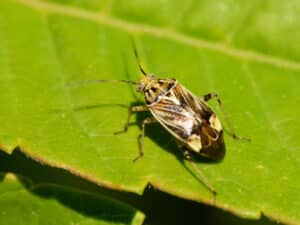
Tarnished Plant Bug
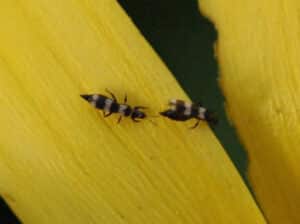
Thrip
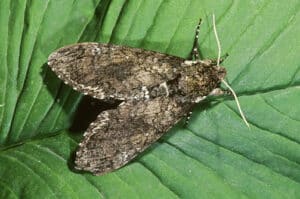
Tomato Hornworm
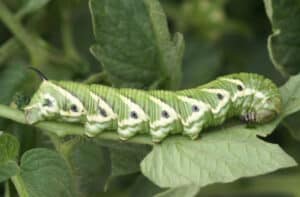
Tomato Moth

Viburnum Beetle

Vine Weevil Larvae
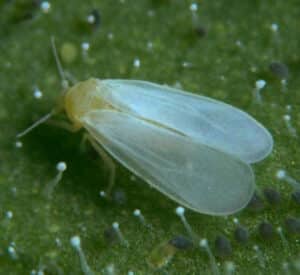
Whitefly

Winter Moth
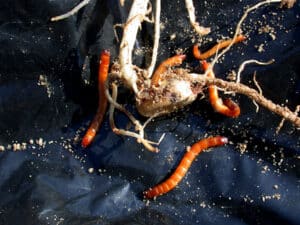
Wireworms
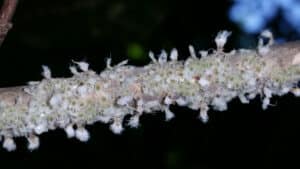
Woolly Beech Aphid
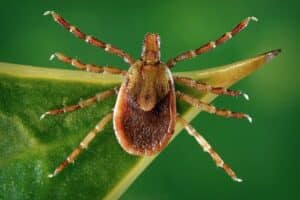
Yellow Dog Tick
Pest Details
Red Spider Mites (Tetranychus urticae)
Red Spider Mites are tiny arachnids, measuring about 1/50 of an inch, making them difficult to spot with the naked eye. They come in various colors, including red, green, or brown, and are known for their distinctive webbing that they produce on the undersides of leaves. These mites feed by piercing plant cells and extracting their contents, which leads to a stippled or speckled appearance on the upper leaf surface. Severe infestations can cause leaves to yellow, wilt, and drop prematurely, weakening the affected plants.
Red Spider Mites are attracted to a wide range of plants, including tomatoes, peppers, beans, and various ornamental flowers. They thrive in hot and dry conditions, making them more common during warm summer months. To avoid attracting these pests, maintain proper plant hygiene by regularly removing dead leaves and debris from your garden, and ensure plants are adequately watered to prevent drought stress.
For organic control, consider introducing natural predators like predatory mites or ladybugs to your garden, as they can help keep Red Spider Mite populations in check. Frequent spraying with a strong stream of water can dislodge the mites from your plants. Neem oil or insecticidal soap can be used as organic treatments, but be sure to follow the label instructions. In severe cases, non-organic options like miticides may be necessary, but use them sparingly and follow safety guidelines to protect beneficial insects and the environment.
Pest Details
Gall Mites (Eriophyidae Family)
Gall Mites are microscopic pests that are challenging to identify with the naked eye due to their minuscule size, usually less than 0.2 millimeters. Their presence is often detected by the symptoms they cause on plants. Gall Mites induce the formation of tiny, abnormal growths known as galls on leaves, stems, or other plant parts. These galls can take various forms, from small blister-like swellings to hair-like protrusions. The affected plant may display stunted growth, distorted leaves, or discoloration.
Gall Mites are attracted to a wide range of plants in North America, including fruit trees like apple and pear, as well as ornamental shrubs and roses. They are generally drawn to plants with tender foliage. To proactively avoid attracting these pests, maintain good garden hygiene by removing and disposing of any affected plant parts or galls promptly. Prune and thin the affected plants to improve air circulation and reduce favorable conditions for infestation.
Eliminating Gall Mites can be challenging due to their microscopic size. Organic methods involve pruning and disposing of infested plant parts, ensuring proper sanitation in the garden, and encouraging natural predators like ladybugs and lacewings. For more aggressive non-organic techniques, consider using chemical miticides labeled for Gall Mite control, but use them as a last resort and follow the product instructions carefully. Frequent monitoring and early intervention are crucial to managing Gall Mite infestations effectively.
Pest Details
Bagworm (Family Psychidae)
The Bagworm is a common garden pest that can harm your plants. These caterpillar-like insects are encased in protective bags made of silk and plant material, often resembling small twigs or cones. The bags can be up to 2 inches long, and the caterpillars use them for camouflage and protection. The damage caused by bagworms is evident as they feed on plant foliage, leading to defoliation and the appearance of brown, dead leaves on affected plants.
Bagworms are attracted to a variety of plants in North America, including evergreens like arborvitae and juniper, as well as deciduous trees and shrubs. They prefer plants with needle-like or narrow leaves, which provide ample hiding spots for their bags. To proactively avoid attracting bagworms, regularly inspect your plants for the presence of small bags hanging from branches and remove them by hand before infestations become severe.
To eliminate bagworms organically, manually pick off the bags and caterpillars from the affected plants, ensuring thorough removal. You can also encourage natural predators like birds and parasitic wasps to help control their population. For more aggressive non-organic methods, consider using chemical insecticides labeled for bagworm control, but use them as a last resort and follow the manufacturer’s instructions carefully. Early detection and manual removal are crucial in effectively managing bagworm infestations in your garden.
Pest Details
Japanese Beetles (Popillia japonica)
Japanese Beetles are easily identifiable by their distinctive appearance. They are approximately half an inch long with a metallic green head and thorax, and copper-colored wings. On each wing cover, you’ll notice a series of white tufts and five small white patches along the sides and rear. Japanese Beetles are notorious plant pests, causing extensive damage to foliage. They feed on the leaves of various plants, leaving behind skeletonized or lace-like leaves with only the veins remaining.
These beetles are attracted to a wide range of plants in North America, particularly favoring roses, fruit trees (like apples and peaches), grapevines, and ornamental plants such as linden trees and crepe myrtles. To proactively deter Japanese Beetles, consider planting resistant species or varieties, like Japanese beetles-resistant roses or fruit tree cultivars. You can also use traps specifically designed to attract and capture Japanese Beetles, which can help reduce their population.
To eliminate Japanese Beetles from affected plants organically, handpick them from your plants in the morning when they are less active, and drop them into a container of soapy water. Neem oil or insecticidal soap can be sprayed on the affected foliage, but ensure thorough coverage. For more aggressive non-organic methods, chemical insecticides labeled for Japanese Beetle control are available, but use them with caution and follow the product instructions carefully. Timing is crucial for effective control, as Japanese Beetles have a short feeding window during their adult stage, typically in mid-summer.
Pest Details
Leaf Miner
Leaf miners are tiny larvae of various insect species that tunnel through the leaves of plants, creating distinctive, winding, and serpentine trails or mines within the leaf tissue. These tunnels are often visible on the surface of the leaves and can vary in color from white to brown, depending on the type of leaf miner and the plant it infests. Leaf miner damage results in weakened, discolored, or distorted leaves, reducing a plant’s ability to photosynthesize and thrive.
Leaf miners are attracted to a wide range of plants in North America, including vegetables like spinach and Swiss chard, ornamental plants such as azaleas and boxwoods, and various trees like birches and oaks. To prevent attracting these pests, maintain good garden hygiene by removing and disposing of affected leaves, as they may contain developing larvae. You can also consider planting resistant varieties or using row covers to protect vulnerable plants.
To eliminate leaf miners organically, you can prune and destroy affected leaves, reducing the population. Beneficial insects like parasitic wasps can help control leaf miners, so avoid using broad-spectrum insecticides that harm beneficials. Neem oil or insecticidal soap can be used as organic options to reduce leaf miner infestations. In severe cases, if non-organic methods are necessary, you can apply chemical insecticides labeled for leaf miner control following the product instructions, but use them as a last resort due to potential harm to beneficial insects and the environment.
Pest Details
Codling Moth (Cydia pomonella)
The Codling Moth is a common garden pest that can be identified by its appearance. Adult moths have a wingspan of about 1/2 inch and are mottled gray with distinct coppery-brown markings on their forewings. The larvae, responsible for the damage, are about 1/2 inch long with a pale pinkish-white body and a dark brown head. They tunnel into the fruit, leaving behind small, brown, corky entry holes, and their feeding causes internal fruit damage and premature fruit drop.
Codling moths are attracted to fruit-bearing trees, especially apple and pear trees, which are commonly found in North American gardens. They lay their eggs on the fruit, and upon hatching, the larvae burrow into the fruit to feed on the seeds and flesh. To proactively avoid attracting these pests, practice good orchard hygiene by removing and destroying fallen or infested fruit promptly. Consider using pheromone traps to monitor and reduce moth populations.
To eliminate Codling Moths organically, wrap trunks of fruit trees with sticky bands to prevent larvae from crawling up to lay eggs. You can also use pheromone traps to disrupt the mating cycle. Applying kaolin clay as a protective barrier on fruit can deter egg-laying. For more aggressive non-organic methods, consider using chemical insecticides labeled for Codling Moth control, but use them as a last resort, following the product instructions carefully. Combining these methods with regular monitoring and good orchard management is essential for effective Codling Moth control.
Pest Details
Winter Moth (Operophtera fagata)
The Winter Moth is a small, grayish-brown moth with a wingspan of about 1 inch (2.5 cm). Male winter moths have feathery antennae, while females have thread-like antennae. These moths typically emerge in late fall or early winter, hence their name. The damage caused by winter moths is primarily during their larval stage. The caterpillars are small and green, with a pale stripe along their sides. They feed voraciously on the leaves of a wide variety of plants, often leading to defoliation. Heavily infested trees and shrubs can show signs of stress, including reduced growth and susceptibility to other pests and diseases.
Winter moths are attracted to a wide range of plants, including deciduous trees and shrubs. They are particularly drawn to fruit trees, such as apple, pear, and cherry, as well as ornamental trees like oak, maple, and birch. To avoid attracting winter moths, you can use sticky traps or barriers, like tree bands, to capture the crawling caterpillars as they move up the tree trunks in the late fall.
Controlling winter moths can be achieved through various methods. For organic control, you can introduce natural predators like parasitic wasps or use biological insecticides containing beneficial nematodes, which infect and kill the caterpillars. Pruning and disposing of infested branches during the winter months can also help reduce the population. In severe infestations, chemical insecticides containing Bacillus thuringiensis (Bt) can be used, but they should be applied carefully to minimize harm to non-target insects. Always follow the label instructions when using chemical treatments.
Pest Details
Aphids (Superfamily Aphidoidea)
Aphids, part of the Aphididae family, are tiny, soft-bodied insects commonly found in gardens across North America. They are usually green or yellow, ranging from 1/16 to 1/8 inches long, with pear-shaped bodies. Aphids can be identified by their two long antennae and the presence of two tube-like structures, called cornicles, on their rear end. Visually, these pests cluster on plant stems and leaves, often appearing as small, slow-moving dots. One visible sign of their presence is the honeydew they excrete, a sticky substance that attracts ants and can lead to sooty mold growth on affected plants.
Aphids are attracted to plants due to their sugary sap. They commonly infest a variety of plants in North America, including roses, vegetables like lettuce and tomatoes, fruit trees, and ornamental shrubs. To proactively deter aphids, consider planting companion plants like marigolds or nasturtiums, which they tend to avoid. Regularly inspect your plants for signs of infestation and hose off aphids with a strong stream of water to dislodge them.
To eliminate aphids organically, you can introduce natural predators like ladybugs or lacewings to your garden. Neem oil or insecticidal soap can also be applied to affected plants, suffocating the aphids. For a more aggressive approach, consider chemical insecticides like pyrethroids, but use them as a last resort, following manufacturer instructions carefully and avoiding harm to beneficial insects. Pruning heavily infested plant parts can also help control the population. Regular vigilance and a combination of these methods can help manage aphids in your garden.
Pest Details
Scale Insects (Superfamily Cocciodea)
Scale insects are tiny, immobile pests that can infest plants. They often appear as small, waxy bumps or scales on plant stems, leaves, or branches. These scales come in various colors, including brown, white, or black, depending on the species. The most noticeable effect on plants is their damage to the leaves, as they feed by piercing the plant tissue and extracting sap. This feeding can result in yellowing of leaves, stunted growth, and, in severe cases, plant decline or death.
Scale insects are attracted to a wide range of plants in North America, including ornamental shrubs, fruit trees, and houseplants. To prevent attracting these pests, maintain good plant health through proper watering and fertilization practices. Regularly inspect your plants for early signs of infestation, such as the presence of scales, and promptly address any issues. Pruning and removing heavily infested plant parts can also help control the population.
Controlling scale insects can be achieved through various methods. Organic approaches involve physically removing the scales with a soft brush or cloth soaked in soapy water or rubbing alcohol. Beneficial insects like ladybugs and lacewings can be introduced to your garden to help control scale populations. Neem oil or horticultural oil sprays can also be effective when applied to plants, suffocating the scales. For more severe infestations, chemical insecticides may be necessary, but use them as a last resort and always follow the product label instructions for safe and effective pest control.
Pest Details
Whitefly (Superfamily Aleyrodiodea)
Whiteflies are small, winged insects that are often identified by their powdery white appearance. They have delicate, moth-like wings and measure about 1-2 millimeters in length. When disturbed, they quickly flutter around the host plant, resembling a small cloud of white dust. The damage caused by whiteflies is primarily due to their feeding habits. They pierce the plant’s leaves and stems with their needle-like mouthparts to feed on the plant sap. This feeding weakens the plant and can lead to symptoms such as yellowing leaves, reduced growth, and the presence of sticky honeydew on leaves.
Whiteflies are attracted to a wide range of plants, including vegetables, ornamentals, and fruit trees. They are particularly fond of plants with soft, tender foliage. To avoid attracting whiteflies, it’s essential to maintain plant health through proper watering and fertilization practices. You can also use reflective mulch or row covers to deter whiteflies from infesting your crops. Natural predators like ladybugs and parasitic wasps can be encouraged in your garden to help control whitefly populations.
Eliminating whiteflies can be achieved through both organic and non-organic methods. For organic control, introduce beneficial insects like ladybugs and lacewings to your garden, which feed on whiteflies. Additionally, neem oil or insecticidal soap can be applied to affected plants as a non-toxic way to deter whiteflies. In severe infestations, chemical insecticides containing pyrethroids or neonicotinoids can be used, but they should be a last resort due to their potential environmental impact and harm to beneficial insects. Always follow the instructions on the product label when using chemical treatments.
Pest Details
Viburnum Beetle (Pyrrhalta viburni)
The Viburnum Beetle is a garden pest known for its distinct appearance. These small beetles are about 6-7 mm in length with an elongated, slender shape. They have metallic blue-black bodies with a reddish-brown head and legs. The most noticeable sign of their presence is the damage they inflict on Viburnum plants. They feed on the leaves, causing characteristic holes and skeletonization of the foliage. Severe infestations can lead to defoliation, weakening the plant and affecting its overall health.
Viburnum Beetles are attracted to various species of Viburnum plants, particularly those in the Viburnum dentatum and Viburnum opulus groups. To prevent infestations, consider diversifying your garden with plants that are less attractive to these beetles. Regularly inspect your Viburnum plants for early signs of infestation, such as skeletonized leaves, and remove and destroy affected foliage. You can also use neem oil or insecticidal soap to control small infestations in an organic way. For more severe cases, chemical insecticides may be necessary, but be sure to follow the manufacturer’s instructions carefully and consider their potential impact on beneficial insects and the environment.
Pest Details
Thrip (Order Thysanoptera)
Thrips are tiny, slender insects, typically measuring around 1 to 2 millimeters in length. They vary in color from yellow to brown or black and have fringed wings, which give them a characteristic appearance. Thrips are challenging to spot individually due to their small size, but their presence is often indicated by the damage they cause. Thrips feed by piercing plant cells and sucking out the contents, resulting in silvery or bronze stippling on leaves. Affected plants may exhibit distorted growth, curled leaves, and reduced fruit or flower quality.
Thrips are attracted to a wide range of plants, including vegetables, ornamentals, and fruit trees. They are particularly drawn to plants with delicate or young foliage. To prevent thrip infestations, consider using row covers for susceptible crops, as this physical barrier can help keep them at bay. Additionally, practicing good garden hygiene by removing weeds and debris can reduce thrip breeding sites.
Organic control methods for thrips include releasing natural predators like lacewings and ladybugs into the garden. Neem oil or insecticidal soap sprays can be effective in reducing thrip populations. For more aggressive control, chemical insecticides may be necessary, but use them as a last resort, following label instructions carefully to minimize harm to beneficial insects and the environment.
Pest Details
Vine Weevil Larvae
Vine Weevil Larvae (Otiorhynchus sulcatus) are a common garden pest that can wreak havoc on your plants. These larvae are C-shaped, creamy-white in color, and have no legs. They typically measure around 1.2 cm (0.5 inches) in length. The damage caused by these pests primarily occurs underground. They feed on the roots of a wide range of plants, weakening them and inhibiting their ability to take up water and nutrients. As a result, affected plants may exhibit wilting, yellowing leaves, and stunted growth.
Vine Weevil Larvae are attracted to a variety of plants, including ornamental shrubs, herbaceous perennials, and even some fruit trees. To prevent infestations, practice good garden hygiene by removing debris and weeds where these larvae can hide. When planting new additions to your garden, consider using root barriers or planting pots with a fine mesh to deter adult Vine Weevils from laying eggs near your plants. You can also apply beneficial nematodes to the soil, which are natural predators of Vine Weevil Larvae, or use insecticides containing imidacloprid for more severe infestations. Be sure to follow application instructions carefully and consider the environmental impact of chemical treatments.
Pest Details
Adult Vine Weevil (Otiorhynchus sulcatus)
The Adult Vine Weevil is a common garden pest that can impact a variety of plants. These weevils are about 1/2 inch long, with a dark, almost black, shiny body. They have a distinctive “snout” and cannot fly. The most noticeable sign of their presence is the characteristic notched or irregularly-shaped leaves on affected plants. They typically feed during the night, making it harder to spot them directly.
Vine weevils are attracted to a wide range of plants in North America, including ornamental plants, shrubs, and various types of container-grown plants. They are especially drawn to plants with broad leaves and lush foliage. To proactively avoid attracting these pests, inspect plants before purchase to ensure they are not infested, and avoid overwatering, as moist soil can be attractive to them.
To eliminate adult vine weevils, you can handpick them at night using a flashlight, as this is when they are most active. Place a cloth or tray underneath the plant to catch them as they fall. Neem oil or insecticidal soap can be applied to the foliage, targeting the weevils when they feed. For more aggressive non-organic methods, consider using chemical insecticides labeled for vine weevil control, but use them as a last resort and follow the manufacturer’s instructions carefully. Combining methods like biological control and vigilant monitoring can help effectively manage vine weevil infestations in your garden.
Pest Details
Cabbage White Caterpillars (Pieris rapae)
The Cabbage White Caterpillar is a common garden pest that can be identified by its appearance. These caterpillars are small, typically about 1 inch in length, and are pale green in color with a faint yellow stripe running down their back. They have smooth bodies with tiny, fine hairs and feed on plant leaves, causing irregular holes and damage. Severely affected plants may exhibit yellowing and stunted growth.
Cabbage White Caterpillars are attracted to plants due to their preference for the brassica family, which includes cabbage, broccoli, cauliflower, and other leafy greens. They are commonly found on these types of vegetables and ornamental plants in North America. To proactively avoid attracting these pests, practice crop rotation, and use physical barriers like row covers to protect susceptible plants.
To eliminate Cabbage White Caterpillars organically, handpick them from plants and drop them into a bucket of soapy water. Introducing natural predators like parasitic wasps and releasing beneficial nematodes into the soil can help control their population. You can also use Bacillus thuringiensis (Bt), a biological insecticide, to target caterpillars specifically, but ensure thorough coverage. For more aggressive non-organic methods, consider using chemical insecticides labeled for caterpillar control, but use them with caution and follow the product instructions carefully. Timely intervention and good garden management are essential in managing Cabbage White Caterpillar infestations.
Pest Details
Tomato Moth (Lacanobia oleracea)
The Tomato Moth, also known as the Old World Bollworm, is a brownish-gray moth with a wingspan of approximately 1.5 inches. Its wings have distinctive markings, including a pale, kidney-shaped spot near the center. While the adult moth may not directly harm plants, it’s the larvae that pose a threat. The caterpillars are greenish-brown with longitudinal stripes and can grow up to 1.5 inches in length. They feed on the foliage, flowers, and fruit of various plants, including tomatoes and peppers. The damage caused includes chewed leaves, flower buds, and even holes in the fruit.
Tomato Moths are attracted to a wide range of host plants, with tomatoes, peppers, and other vegetables being common targets. To prevent infestations, consider using row covers to protect your plants from adult moths. Crop rotation can also help break the lifecycle by preventing them from finding their preferred hosts in the same location year after year. Hand-picking the caterpillars when spotted is an effective organic control method. You can also encourage natural predators like parasitic wasps and birds in your garden. If infestations are severe, insecticidal sprays may be necessary, following label instructions carefully.
Pest Details
Rose Slug (Arge ochropus)
The Rose Slug is a common garden pest with distinctive features. These slim, greenish-yellow larvae are about 1/2 inch long, resembling small caterpillars. They have translucent bodies with a dark head and prolegs on their abdomen. The damage caused by Rose Slugs is evident in the form of skeletonized or tattered leaves. These pests feed on the soft tissues of rose plants, leaving behind a lacy pattern on the leaves, which can be quite unsightly.
Rose Slugs are attracted to rose plants primarily due to their preference for the tender foliage of these plants. They are commonly found on various types of roses in North America. To prevent infestations, consider planting rose varieties that are less susceptible to Rose Slugs, and monitor your plants regularly for early signs of damage.
Eliminating Rose Slugs can be done using both organic and non-organic methods. Organic approaches involve manually picking off the slugs and disposing of them. Additionally, introducing natural predators like ladybugs or lacewings to your garden can help control these pests. Non-organic options include using insecticidal soaps or neem oil sprays, which can be effective when applied directly to the pests. Always follow the product label instructions carefully to ensure the safety of your plants and the environment. Proper garden hygiene, including cleaning up fallen leaves and debris, can also help reduce Rose Slug populations.
Pest Details
Grasshopper (Suborder Caelifera)
Grasshoppers are large, herbivorous insects that are easily identified by their long legs, strong hind legs for jumping, and distinctive, elongated bodies, typically ranging in size from 1 to 4 inches. They come in various colors, including green, brown, or a combination of these, often blending with their surroundings. Grasshoppers can cause significant damage to plants by chewing on leaves and stems. This results in ragged, irregularly shaped holes in the foliage and can lead to stunted growth or defoliation of the affected plants.
Grasshoppers are attracted to a variety of plants in North America, particularly those with tender foliage. Common targets include vegetables like beans, tomatoes, and corn, as well as ornamental plants like roses and hollyhocks. To proactively deter Grasshoppers, use physical barriers like row covers or netting to protect vulnerable plants. Planting aromatic herbs like basil and cilantro nearby may also help repel them due to their strong scents.
To eliminate Grasshoppers from affected plants organically, consider using a homemade garlic or hot pepper spray applied to the foliage. Neem oil or insecticidal soap can also be effective when sprayed directly on the Grasshoppers. For more aggressive non-organic methods, chemical insecticides labeled for Grasshopper control can be used, but exercise caution and follow the product instructions meticulously. Additionally, you can encourage natural predators like birds and praying mantises to help control the Grasshopper population in your garden. Regular monitoring and timely intervention are key to managing Grasshopper infestations effectively.
Pest Details
Stink Bug (Pentatomidae Family)
Stink bugs are recognizable by their distinctive shield-shaped bodies, usually ranging from 1/2 to 3/4 inches in length. They come in various colors, including brown, green, and gray, often with mottled patterns on their backs. Stink bugs are sap-sucking insects that use their needle-like mouthparts to pierce plant tissues and feed on the plant’s juices. This feeding activity can cause wilting, discoloration, and distorted growth in plants.
Stink bugs are attracted to a wide range of plants, but they particularly favor fruits and vegetables such as tomatoes, peppers, and fruit trees. To prevent stink bug infestations, it’s essential to maintain good garden hygiene by removing plant debris and weeds, as these pests overwinter in such areas. Implementing physical barriers like row covers during the growing season can also help protect plants.
Controlling stink bugs can be achieved through various methods. For organic control, consider handpicking stink bugs and dropping them into a container of soapy water. Beneficial insects like parasitoid wasps can help reduce stink bug populations naturally. Neem oil and insecticidal soap are organic options for spraying on affected plants. If infestations are severe, chemical insecticides containing pyrethroids can be used, but use them judiciously and follow label instructions to minimize harm to beneficial insects and the environment.
Pest Details
Sawfly Larvae (Suborder Symphyta)
Sawfly larvae are garden pests with distinctive characteristics. These larvae typically resemble caterpillars but can be distinguished by the presence of more prolegs and tiny, dark-colored spots along their bodies. They come in various colors, including green, yellow, or black, depending on the species. The damage they cause to plants is evident as irregularly chewed or skeletonized leaves, which can make affected plants look unsightly.
Sawfly larvae are attracted to a wide range of plants in North America, including roses, fruit trees, and ornamental shrubs. To prevent infestations, maintain good garden hygiene by removing fallen leaves and debris, which can harbor overwintering larvae. Additionally, regular inspection of your plants for early signs of infestation can help you catch and address the problem before it escalates.
Controlling Sawfly larvae can be achieved using organic and non-organic methods. Organic approaches include physically removing the larvae by hand or shaking them off the plants into a container of soapy water. Natural predators like birds and beneficial insects can also help keep Sawfly populations in check. Non-organic options include using insecticidal sprays, such as neem oil or pyrethrin-based products, which can be effective when applied directly to the larvae. Always follow the product label instructions for safe and effective pest control.
Pest Details
Woolly Beech Aphid (Phyllaphis grandifoliae)
The Woolly Beech Aphid is a small, pear-shaped insect that measures around 1/8 inch (3 mm) in length. These aphids are typically covered in a waxy, white, wool-like substance, which gives them their name. They cluster on the undersides of beech tree leaves, forming dense colonies. Infested plants may exhibit yellowing or curling leaves, stunted growth, and a sticky residue known as honeydew on the leaves and surrounding surfaces.
Woolly Beech Aphids are attracted to beech trees (Fagus species) commonly found in North America. To avoid attracting these pests, maintain good garden hygiene and keep an eye on beech trees for early signs of infestation. Prune and dispose of heavily infested branches and leaves. You can also introduce natural predators like ladybugs and lacewings to your garden, which feed on aphids.
For organic control, a strong blast of water can dislodge aphids from affected plants. Neem oil or insecticidal soap can be used to treat infestations on smaller plants. For more aggressive measures, chemical insecticides containing neonicotinoids or pyrethroids can be applied, but use them as a last resort and follow the manufacturer’s instructions carefully while taking care to minimize harm to beneficial insects and pollinators.
Pest Details
Earwig (Order Dermaptera)
The Earwig is a garden pest that can be identified by its appearance. These insects are about 1/2 to 1 inch long and have elongated, flattened bodies with dark brown or reddish-brown coloration. They have distinctive pincers or forceps-like cerci at the end of their abdomen, which are used for defense and mating. While Earwigs are generally not plant eaters, they can occasionally feed on plant material, causing minor damage like irregular holes in leaves and flowers.
Earwigs are attracted to damp, dark environments and are commonly found in gardens with mulch or decaying organic matter. They are not highly selective in their plant preferences but can be commonly found around vegetables, ornamental plants, and flowers. To proactively avoid attracting these pests, maintain good garden hygiene by removing debris, decaying plant matter, and excess mulch. You can also trap them using rolled-up newspapers or cardboard tubes filled with straw or paper.
To eliminate Earwigs organically, set up traps using newspaper or cardboard traps filled with straw or paper, and collect the trapped insects daily. Creating a barrier of diatomaceous earth or crushed eggshells around plant stems can deter them from climbing and causing damage. For more aggressive non-organic methods, consider using chemical insecticides labeled for Earwig control, but use them with caution and follow the product instructions carefully. Regular monitoring and habitat modification are key to managing Earwig infestations in your garden.
Pest Details
Cabbage Looper Caterpillar (Family Noctuidae)
The Cabbage Looper Caterpillar, belonging to the family Noctuidae, is a common garden pest recognizable by its appearance. These caterpillars are typically green with a white stripe running along their sides, which causes them to “loop” or arch their bodies as they crawl. They have three pairs of true legs and several pairs of prolegs, which give them their characteristic looping movement. The damage caused by cabbage loopers is evident in chewed leaves, with irregular holes and ragged edges. Severely affected plants may display reduced growth and yield.
Cabbage looper caterpillars are attracted to plants, particularly those in the brassica family, which includes cabbage, broccoli, and cauliflower. They are also commonly found on other leafy vegetables and ornamental plants. To proactively avoid attracting these pests, practice crop rotation, and interplant with companion plants that deter them, such as marigolds. Covering vulnerable plants with floating row covers can also help prevent infestations.
To eliminate cabbage looper caterpillars organically, handpick them from plants and drop them into a bucket of soapy water. Introducing natural predators like parasitic wasps and releasing beneficial nematodes into the soil can help control their population. You can also use Bacillus thuringiensis (Bt), a biological insecticide, to target caterpillars specifically, but ensure thorough coverage. For more aggressive non-organic methods, consider using chemical insecticides labeled for caterpillar control, but use them cautiously and follow the product instructions carefully. Timely intervention and good garden management are essential in managing cabbage looper caterpillar infestations.
Pest Details
Cucumber Beetle (Family Chrysomelidae)
The Cucumber Beetle is a common garden pest identifiable by its appearance. These small beetles are about 1/4 inch long and have a distinctive yellow-green or yellow-orange coloration with black spots or stripes, depending on the species. They have a hardened shell-like body and are known for their voracious appetite. The damage caused by Cucumber Beetles is evident in the form of chewed leaves, flowers, and fruit. Their feeding can lead to reduced crop yield, plant stress, and the transmission of bacterial wilt disease.
Cucumber Beetles are attracted to plants in the Cucurbitaceae family, which includes cucumbers, squash, zucchini, and melons. They are also commonly found on other garden plants, including beans and corn. To proactively avoid attracting these pests, practice crop rotation by moving cucurbit crops to different areas each season, and consider using physical barriers like row covers to protect vulnerable plants during the early growth stages.
To eliminate Cucumber Beetles organically, inspect plants regularly for the presence of beetles and larvae and remove them by hand, dropping them into soapy water. Introduce natural predators like parasitic wasps and beneficial nematodes to help control their population. Neem oil or insecticidal soap can be applied to deter feeding. For more aggressive non-organic methods, consider using chemical insecticides labeled for Cucumber Beetle control, but use them with caution and follow the product instructions carefully. Timely intervention and good garden management are key to managing Cucumber Beetle infestations.
Pest Details
Mealybugs (Family Pseudococcidae)
Mealybugs are small, soft-bodied insects that are typically covered in a white, waxy, cotton-like substance. They often cluster together, resembling tiny, fluffy cotton balls on plant stems and leaves. Mealybug infestations can cause several visible symptoms on plants, including yellowing or curling of leaves, stunted growth, and a sticky, honeydew residue on the affected parts. Additionally, you may notice the presence of ants near mealybugs, as ants are attracted to the honeydew they produce.
Mealybugs are attracted to a wide range of plants in North America, including ornamentals like hibiscus and succulents, fruit trees such as citrus, and indoor houseplants like spider plants. To avoid attracting these pests, practice good plant hygiene by inspecting new plants before introducing them to your garden or home. Isolate infested plants to prevent the spread of mealybugs.
For organic control of mealybugs, you can use a mixture of water and dish soap to physically remove them. Neem oil or insecticidal soap can also be effective when applied directly to the pests. Beneficial insects like ladybugs and lacewings are natural predators of mealybugs and can help keep their populations in check. If the infestation is severe, consider using neonicotinoid-based insecticides as a more aggressive option, but exercise caution as these chemicals can harm beneficial insects and pollinators. Always follow label instructions when using any pesticide.
Pest Details
Tomato Hornworm (Manduca quinquemaculata)
The Tomato Hornworm, often mistaken for its close relative, the Tobacco Hornworm, is a large, green caterpillar that can reach up to 4 inches in length. It’s easily identified by its bright green color, with diagonal white stripes along its sides and a distinctive “horn” on its posterior end. These voracious caterpillars feed on the leaves and stems of tomato plants, causing extensive defoliation. Their presence can lead to reduced fruit production and stunted plant growth.
Tomato Hornworms are attracted to a variety of plants in the nightshade family, with tomatoes and peppers being their favorites. To deter them, consider planting companion plants like basil and marigolds, which can help repel these pests. Hand-picking is an effective organic method for control; simply remove the caterpillars from your plants when you spot them. Additionally, encouraging natural predators like parasitic wasps and birds can help keep their populations in check. For more aggressive control, insecticidal sprays or dusts can be used, but always follow label instructions and avoid harming beneficial insects.
Pest Details
Slugs
Slugs are common garden pests that can be identified by their soft, slimy, elongated bodies, usually ranging in color from gray to brown. They leave a telltale trail of slime wherever they move, which can help in spotting their presence. These pests are primarily nocturnal, so you may not often see them during the day. Their feeding results in irregularly shaped holes in leaves, particularly on young seedlings and the lower leaves of established plants.
Slugs are attracted to plants due to their moisture-rich and tender foliage. They are commonly found munching on a variety of garden plants, including hostas, lettuce, cabbage, and marigolds. To avoid attracting slugs, keep your garden well-drained and avoid overwatering. Applying a layer of mulch can help keep the soil surface dry and less appealing to slugs. Additionally, planting slug-resistant species and using raised beds or containers can minimize their access to your plants.
Controlling slugs can be achieved through organic and common techniques. Handpicking slugs during the evening hours when they’re active is an effective method. You can also create slug traps by burying containers filled with beer in the soil; slugs are attracted to the scent and will crawl in and drown. Copper tape or barriers can be placed around the base of plants, as slugs are deterred by the electric charge it generates. For a more aggressive approach, commercial slug baits or traps are available, but use them cautiously and follow the label instructions.
Pest Details
Snails
Snails are garden pests that can be identified by their coiled, spiral-shaped shells. These shells are typically brown or grayish in color, but snail appearance can vary. They leave a shiny, silvery trail behind them as they move, which is a clear sign of their presence in your garden. Snails primarily feed on the leaves of plants, resulting in irregular holes and chewed edges. Their feeding can be particularly damaging to tender seedlings and the foliage of various garden plants.
Snails are attracted to plants due to their moisture-rich and tender foliage. They are commonly found feasting on a wide range of garden plants, including lettuce, hostas, and various ornamental flowers. To avoid attracting snails, maintain a dry and well-drained garden environment, as they thrive in damp conditions. Regularly remove debris, leaf litter, and hiding spots like boards or rocks where snails like to shelter during the day. Additionally, you can create physical barriers around susceptible plants, such as copper strips or diatomaceous earth, as snails are reluctant to cross these rough surfaces.
Controlling snails can be achieved through organic and common techniques. Handpicking snails during the evening hours when they’re active is an effective method. You can also use beer traps by burying containers filled with beer in the soil; snails are attracted to the scent and will crawl in and drown. Copper barriers, such as tape or mesh, can be installed around plant bases to deter snails. For a more aggressive approach, commercial snail baits containing iron phosphate or metaldehyde are available, but use them carefully and follow label instructions to avoid harm to non-target species.
Pest Details
Flea Beetle (Family Chrysomelidae)
The Flea Beetle is a common garden pest identifiable by its small, oval-shaped body (typically less than 1/8 inch long) and its ability to jump when disturbed, much like a flea. They come in various colors, including metallic blue, black, or bronze. Flea Beetles are notorious for causing small, round holes or pits in the leaves of plants. The damage is characterized by a lace-like appearance, giving affected leaves a ragged and unhealthy look.
Flea Beetles are attracted to a variety of plants in North America, including vegetables like eggplants, potatoes, radishes, and beans, as well as ornamental plants like roses. They are particularly drawn to plants with tender leaves. To proactively avoid attracting these pests, consider using row covers or protective screens to physically block them from accessing your plants. Planting companion crops like marigolds and nasturtiums can deter them due to their strong scent and taste.
To eliminate Flea Beetles organically, use insecticidal soap or neem oil sprays, which can be effective in reducing their population when applied to both sides of leaves. Handpicking and dropping the beetles into a container of soapy water can also help control them. For more aggressive non-organic methods, consider using chemical insecticides labeled for Flea Beetle control, but use them with caution and follow the product instructions carefully. Regular monitoring and early intervention are essential for managing Flea Beetle infestations in your garden.
Pest Details
Colorado Potato Beetle (Lema daturaphila)
The Colorado Potato Beetle is a common garden pest that can be identified by its appearance. Adult beetles are about 1/3 inch long with an oval-shaped body. They have distinctive yellow-orange bodies with black stripes running along their wing covers. Their larvae are red with black head capsules and are about 1/4 inch long. The damage caused by Colorado Potato Beetles is evident in chewed and skeletonized leaves, often leading to significant defoliation of potato plants and other related crops.
Colorado Potato Beetles are attracted to plants in the Solanaceae family, which includes potatoes, tomatoes, eggplants, and peppers. These plants are commonly grown in North American gardens. To proactively avoid attracting these pests, practice crop rotation by planting potatoes and other susceptible crops in different locations each year. Handpicking and removing adult beetles and larvae regularly can also help prevent infestations.
To eliminate Colorado Potato Beetles organically, handpick and destroy both adults and larvae from affected plants, dropping them into soapy water. Neem oil or insecticidal soap can be applied to the foliage, targeting the beetles when they feed. Encouraging natural predators like ladybugs and lacewings can also help control their population. For more aggressive non-organic methods, consider using chemical insecticides labeled for Colorado Potato Beetle control, but use them with caution and follow the product instructions carefully. Timely intervention and good garden management are essential in managing Colorado Potato Beetle infestations.
Pest Details
Mexican Bean Beetle (Epilachna varivestis)
The Mexican Bean Beetle is a garden pest that is approximately 1/4 inch long and oval-shaped with a yellow-orange body covered in black spots. They have a similar appearance to ladybugs but with distinct differences in coloration. These beetles feed on various bean plants, including green and snap beans, and they can cause significant damage. The Mexican Bean Beetle larvae are soft-bodied, grub-like, and yellow with spines along their bodies.
Mexican Bean Beetles are attracted to bean plants due to their preference for the foliage and pods of these plants. They are commonly found on beans in North America, particularly during the warmer months. To avoid attracting Mexican Bean Beetles, you can plant your beans early in the season before the beetles become active, as they tend to be more problematic in mid to late summer. Additionally, practicing crop rotation and interplanting with other vegetables can help deter these pests.
For organic control, handpick the beetles and larvae from your plants, especially in the early morning when they are less active. Beneficial insects like ladybugs and parasitic wasps can help keep Mexican Bean Beetle populations in check. Neem oil or insecticidal soap can be applied to the affected plants, but be sure to follow the label instructions. If the infestation is severe, consider using pyrethrin-based insecticides as a more aggressive option, but use caution to minimize harm to beneficial insects and pollinators.
Pest Details
Tarnished Plant Bug (Lygus lineolaris)
The tarnished plant bug is a small, oval-shaped insect, measuring around 1/4 inch in length. It varies in color but often appears mottled brown with distinctive diamond-shaped markings on its back. These pests feed by piercing plant tissues and extracting juices, leading to symptoms like distorted or stunted plant growth, deformed fruits, and small, brown, corky spots on fruit and foliage.
Tarnished plant bugs are attracted to a wide range of plants, including strawberries, tomatoes, cotton, and various ornamental plants. They’re particularly drawn to young, tender plant growth. To deter these pests, it’s important to maintain good garden hygiene by removing weeds, dead plant material, and overwintering sites like leaf litter. Additionally, planting a diverse range of plants can help disrupt their feeding patterns.
Organic control methods for tarnished plant bugs include using insecticidal soaps or neem oil sprays to deter and kill the bugs. Beneficial insects like ladybugs and lacewings can help keep their populations in check. For more aggressive control, consider using chemical insecticides, but exercise caution and follow label instructions to minimize harm to beneficial insects and the environment.
Pest Details
RIFA–Red Imported Fire Ant (Solenopsis invicta)
Red Imported Fire Ants, commonly referred to as RIFA, are small reddish-brown to reddish-black ants, ranging from 1/8 to 1/4 inch in length. They are identified by their aggressive behavior and painful stings, which are felt when disturbed. These ants build dome-shaped nests in the soil, often with multiple entrance holes. While they primarily feed on small insects and sugary substances, they can affect plants indirectly. RIFA create mounds in garden beds, displacing soil and potentially causing damage to plant roots. They can also farm aphids for honeydew, which can lead to damage to plant leaves due to aphid feeding.
RIFA are attracted to plants for two main reasons: they are drawn to the honeydew produced by sap-sucking insects like aphids and mealybugs, and they may nest near moist, well-watered garden areas. To avoid attracting these ants, regularly inspect your plants for signs of aphids and other sap-sucking insects, treating infestations promptly. Additionally, maintain good garden hygiene by eliminating standing water and excessive moisture in your garden beds.
To eliminate RIFA from affected plants, first, focus on controlling their nest. For organic control, use boiling water or a mixture of dish soap and water to drench the mound. Commercial ant baits with boric acid can be effective in attracting and killing the ants. For non-organic options, chemical ant killers are available, but use them with caution and follow the label instructions, as these chemicals can be harmful to beneficial insects and the environment. Integrated pest management techniques may involve a combination of baiting, nest destruction, and habitat modification for effective control.
Pest Details
Cutworm (Family Noctuidae)
The Cutworm is a common garden pest that can be identified by its appearance. These caterpillars are typically gray or brown with smooth, cylindrical bodies, and they can range from 1/2 to 2 inches in length. They are nocturnal and hide in the soil during the day. The damage caused by Cutworms is evident in young seedlings and transplants, as they cut through the stems at the base, causing the plants to wilt and collapse.
Cutworms are attracted to a variety of garden plants, including vegetables like tomatoes, peppers, lettuce, and flowers. They are primarily drawn to the tender stems of young plants. To proactively avoid attracting these pests, use protective collars, such as cardboard or plastic, around the base of young plants to create a barrier and prevent cutworms from reaching them.
To eliminate Cutworms organically, handpick them from the soil or affected plants during the evening when they are active. Promote natural predators like ground beetles and parasitic nematodes in your garden, as they can help control Cutworm populations. Applying diatomaceous earth or neem oil around the base of plants can also deter them. For more aggressive non-organic methods, consider using chemical insecticides labeled for Cutworm control, but use them with caution and follow the product instructions carefully. Vigilance and preventive measures are essential for managing Cutworm infestations in your garden.
Pest Details
Asparagus Beetle (Genus Chrysomelidae)
The Asparagus Beetle is a common garden pest that primarily affects asparagus plants. These beetles are small, about 1/4 inch long, and have distinctive black or bluish-black bodies with red-orange markings. They have elongated bodies and are easily identifiable by their prominent antennae. The damage caused by asparagus beetles can be seen as chewed foliage and noticeable egg masses laid on the tips of asparagus spears, which resemble small, dark beads. Heavily infested plants may exhibit reduced vigor and yield.
Asparagus beetles are attracted to asparagus plants due to their preference for asparagus foliage and young shoots. They are commonly found on asparagus in North America. To proactively avoid attracting these pests, practice good garden hygiene by removing and destroying any egg masses you find, especially in early spring. You can also use floating row covers to protect young asparagus shoots from adult beetles.
To eliminate asparagus beetles organically, handpick and destroy adult beetles and larvae regularly. Introducing natural predators like ladybugs can help control their population. Neem oil or insecticidal soap can be used to treat infestations, but ensure thorough coverage and follow the product instructions. For more aggressive non-organic methods, consider chemical insecticides labeled for use on asparagus, but use them sparingly and follow the manufacturer’s instructions carefully. Timely intervention and good garden management are crucial in managing asparagus beetles and protecting your asparagus crop.
Pest Details
Wireworms (Family Elateridae)
Wireworms are slender, brown or yellowish-brown, hard-bodied larvae of click beetles. They typically range in size from 1/2 to 1 inch (1.3 to 2.5 cm) and have a cylindrical shape with a tough, segmented exterior. Wireworms are subterranean pests that feed on plant roots and underground plant parts, making them difficult to detect. The damage they cause results in stunted growth, wilted or yellowing foliage, and even plant death.
Wireworms are attracted to a wide range of plants, including potatoes, carrots, corn, and other root vegetables. They are also known to infest grassy areas, making them a concern for lawns and turf. To avoid attracting wireworms, practice crop rotation, as these pests tend to build up in soil when the same crops are grown repeatedly in the same location. Additionally, maintaining good soil drainage and reducing organic matter can deter wireworms, as they prefer damp and organic-rich soil.
Controlling wireworms organically can be challenging, but beneficial nematodes or entomopathogenic fungi can help reduce their numbers. These natural predators can be applied to the soil to target wireworm larvae. For a more aggressive approach, chemical treatments containing insecticides like imidacloprid or carbaryl can be used. Apply these treatments according to label instructions, and take care to protect beneficial insects in the area.
Pest Details
European Corn Borer (Ostrinia nubilalis)
The European Corn Borer is a garden pest that can be identified by its appearance. In its larval stage, it is a pale, cream-colored caterpillar with brown head capsules, typically growing up to 1 inch long. As it matures, it may develop dark spots and fine hairs on its body. The damage caused by European Corn Borers is characterized by the presence of tunnels and holes in the stalks and ears of corn and other crops like peppers and tomatoes. These tunnels weaken the plant’s structural integrity and reduce crop yield.
European Corn Borers are attracted to a variety of plants in North America, with corn being their primary host. They are also known to infest peppers, tomatoes, and other related crops. To proactively avoid attracting these pests, practice crop rotation by planting different crops in the affected area each year, as this disrupts their life cycle and reduces infestation. Additionally, choose early-maturing varieties of crops, as they are less susceptible to infestation.
To eliminate European Corn Borers organically, inspect plants regularly for signs of infestation, such as entry holes or frass (caterpillar excrement). Handpick and destroy affected caterpillars and eggs. Wrap the base of young corn plants with collars made of newspaper or cardboard to prevent egg-laying. Introduce natural predators like parasitic wasps into your garden. For more aggressive non-organic methods, consider using chemical insecticides labeled for European Corn Borer control, but use them with caution and follow the product instructions carefully. Early detection and preventive measures are crucial in managing European Corn Borer infestations.
Pest Details
Yellow Dog Tick (Haemaphysalis leachi)
The Yellow Dog Tick is a parasitic arachnid that primarily affects animals rather than plants. Therefore, it doesn’t directly harm plants. This tick is typically brown and can range in size from 3 to 5 mm when unfed and up to 12 mm when engorged after feeding on a host. It is recognized by its flattened oval shape and eight legs.
Yellow Dog Ticks are attracted to animals, especially dogs, and can transmit diseases like canine ehrlichiosis and canine babesiosis. They are not attracted to plants and do not affect them directly. To avoid attracting these ticks, it’s essential to keep your pets, particularly dogs, well-groomed and regularly check for ticks after spending time outdoors, especially in wooded areas.
Eliminating Yellow Dog Ticks from your pets involves using tick-preventive medications, regular grooming, and checking your pets for ticks. Organic methods include using neem oil or natural tick-repellent collars for your pets. For more aggressive control, consult with a veterinarian for prescription tick prevention products. While this pest doesn’t directly affect plants, it’s essential to protect your pets from tick infestations for their health and your family’s well-being.
Pest Details
Squash Bug (Family Correiae)
Squash bugs are easily identified by their elongated, shield-shaped bodies, typically measuring around 5/8 inches in length. They are brownish-gray in color with alternating black and orange stripes along their abdomen edges. These pests primarily affect plants by feeding on their leaves and stems, causing wilting, browning, and the formation of yellow spots. Squash bug eggs are a common sight on the undersides of leaves, appearing as small, bronze-colored clusters.
Squash bugs are attracted to plants such as squash, pumpkins, zucchinis, and other cucurbit family members. To prevent their infestation, it’s essential to keep your garden clean and free of plant debris, as they overwinter in garden debris. You can also plant cucurbit crops away from previously infested areas and use row covers to physically block access to the plants. Additionally, interplanting with nasturtiums or radishes can deter squash bugs, as they dislike the scent of these companion plants.
Controlling squash bugs can be achieved through both organic and common techniques. Handpicking and crushing the bugs and their eggs is effective, but it requires diligence. Neem oil and insecticidal soap are organic options to consider for spraying on affected plants. If infestations are severe, chemical insecticides containing pyrethroids can be used as a last resort, but use them cautiously and follow label instructions carefully to minimize harm to beneficial insects and pollinators.
Pest Details
Black Carpenter Ant (Camponotus pennsylvanicus)
The Black Carpenter Ant is a garden pest known for its large size, typically ranging from 1/4 to 1/2 inch in length. They have a glossy black body and a single narrow waist segment that distinguishes them from termites. While carpenter ants primarily feed on insects and sugary substances, they can indirectly affect plants by excavating nesting galleries in wood, including tree trunks and branches. Such activity can weaken the structural integrity of trees, potentially causing branches to break or die back.
Carpenter ants are not typically attracted to plants for food, but they may nest in trees and shrubs if there is decay or moisture damage. They are commonly found around trees and shrubs in North America. To avoid attracting these ants, maintain proper tree and shrub care, ensuring that plants are healthy and free from rot or decay. Regularly inspect your garden for signs of carpenter ant activity, such as small holes in wood surfaces.
To eliminate carpenter ants from affected plants, locate and destroy their nests within the plant, if possible. You can also use bait stations containing ant baits specifically designed for carpenter ants. These baits are carried back to the nest and can help control the colony. For more aggressive non-organic methods, consider using chemical insecticides labeled for carpenter ant control, but use them with caution and follow the product instructions carefully. Regular monitoring and early intervention are key to managing carpenter ants in your garden.
Pest Details
Corn Earworm (Helicoverpa zea)
The Corn Earworm is a common garden pest that can be identified by its appearance. The adult moths have a wingspan of about 1.5 inches and typically exhibit varying shades of brown with distinctive dark markings. The larvae, responsible for the damage, are about 1 to 1.5 inches long and have a smooth body with various colors, ranging from green to pink or brown, often with longitudinal stripes. The damage caused by Corn Earworms is evident in the form of holes and tunnels in the kernels of corn, tomatoes, and other crops, leading to reduced crop quality.
Corn Earworms are attracted to a variety of plants in North America, including corn, tomatoes, peppers, and various other vegetables. They are drawn to plants during their reproductive phase when flowers are present, as they lay their eggs on the flowers and the larvae later feed on the developing fruit. To proactively avoid attracting these pests, use pheromone traps to monitor adult moth activity and consider planting varieties that have shorter growing seasons to escape peak infestation periods.
To eliminate Corn Earworms organically, inspect plants regularly for signs of infestation and handpick the larvae, dropping them into soapy water. Applying insecticidal soap or neem oil to the flowers can also help deter egg-laying. Bacillus thuringiensis (Bt) is a biological insecticide that specifically targets caterpillars like the Corn Earworm and can be applied to plants. For more aggressive non-organic methods, consider using chemical insecticides labeled for Corn Earworm control, but use them with caution and follow the product instructions carefully. Timely intervention and vigilant monitoring are crucial in managing Corn Earworm infestations in your garden.
Pest Details
Leaf Roller (Family Tortricidae):
The Leaf Roller is a common garden pest known for its distinctive behavior of rolling leaves around itself, creating a protective shelter. These pests are typically small caterpillars, often green or brown, and can vary in size depending on their developmental stage. The most telling characteristic is their habit of rolling leaves into tubes or shelters, which they inhabit while feeding. Leaf roller damage includes chewed or skeletonized leaves enclosed within these rolled shelters, which can weaken plants and make them susceptible to disease.
Leaf Rollers are attracted to a variety of plants in North America, including fruit trees like apple and pear, ornamental shrubs such as roses and azaleas, and many vegetable crops like tomatoes and lettuce. To avoid attracting these pests, maintain good garden hygiene by removing and disposing of affected leaves and leaf-rolled shelters as soon as you notice them. Inspect plants regularly for signs of infestation.
To eliminate Leaf Rollers organically, manually remove and destroy the rolled leaves and caterpillars. Beneficial insects like parasitic wasps and natural predators like birds can help keep their populations in check. You can also use pheromone traps to disrupt their mating patterns. If infestations are severe, consider applying Bt (Bacillus thuringiensis) insecticide, a natural bacterial pesticide that specifically targets caterpillars while sparing beneficial insects. For more aggressive control, chemical insecticides labeled for Leaf Roller control can be used, but use them as a last resort and follow product instructions carefully.
Pest Details
Beetle Grub (Superfamily Scarabaeoidea)
Beetle grubs are common garden pests that can negatively impact your plants. These larvae are typically creamy-white, C-shaped, and have soft bodies. They can vary in size depending on the beetle species. The damage caused by beetle grubs is primarily to plant roots, as they feed on the root system. Signs of infestation include wilting, yellowing, and stunted growth of plants, as well as the presence of adult beetles in the garden.
Beetle grubs are attracted to plants because they feed on plant roots and decaying organic matter in the soil. They commonly infest a variety of plants in North America, including grasses, vegetables, ornamental shrubs, and fruit trees. To proactively avoid attracting these pests, maintain good garden hygiene by removing decaying plant material and thatch from lawns, as these can serve as breeding grounds. Regularly inspect your plants for signs of wilting and yellowing, which may indicate a grub infestation.
To eliminate beetle grubs organically, encourage natural predators like birds, toads, and beneficial nematodes that feed on them. Applying beneficial nematodes to the soil can effectively control grub populations. For more aggressive non-organic methods, consider using chemical insecticides labeled for grub control, but use them with caution and follow the product instructions carefully. Timely intervention and proper lawn care practices are essential in managing beetle grubs and protecting your garden.
Pest Details
Four-Lined Plant Bug (Poecilocapsus lineatus)
The Four-Lined Plant Bug is a garden pest identifiable by its distinctive appearance. It is a slender, elongated insect measuring about 1/4 inch in length with a bright green body and four distinct orange or yellow stripes running lengthwise along its wings. The damage caused by these plant bugs is characterized by small, irregular-shaped holes and yellow stippling on leaves. Severe infestations can lead to plant wilting and reduced flower and fruit production.
Four-Lined Plant Bugs are attracted to a wide range of plants in North America, including perennials, herbs, and vegetables. They are particularly drawn to plants with succulent, tender foliage. To proactively avoid attracting these pests, consider planting a diverse range of species in your garden to reduce the risk of large infestations. Maintaining good garden hygiene by removing debris and weeds can also help deter them.
To eliminate Four-Lined Plant Bugs organically, handpick them from affected plants and drop them into a container of soapy water. Prune and remove heavily infested plant parts to reduce their population. Attract natural predators like ladybugs and lacewings by planting nectar-rich flowers nearby. For more aggressive non-organic methods, consider using chemical insecticides labeled for plant bug control, but use them with caution and follow the product instructions carefully. Regular monitoring and early intervention are key to managing Four-Lined Plant Bug infestations in your garden.


